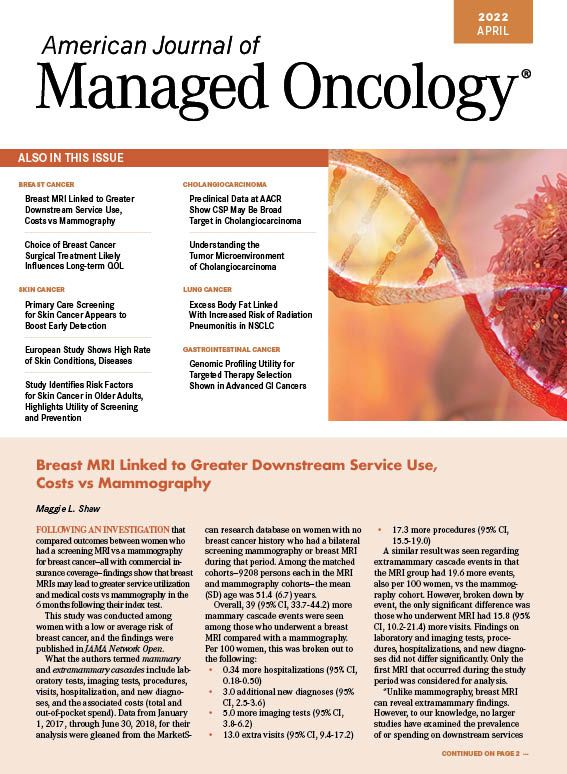- Center on Health Equity & Access
- Clinical
- Health Care Cost
- Health Care Delivery
- Insurance
- Policy
- Technology
- Value-Based Care
Choice of Breast Cancer Surgical Treatment Likely Influences Long-term QOL
This new study used data on women with stage 0 to II breast cancer to investigate their long-term quality of life (QOL) as it related to choice of surgery and the decision to undergo adjuvant radiation therapy.
The choice to have breast-conserving surgery and adjuvant radiation therapy (RT) led to superior outcomes with regard to psychosocial and sexual well-being vs choosing mastectomy and reconstruction without RT among a group of women with a diagnosis of stage 0 to II breast cancer, reports a study published in JAMA Surgery today.
Findings also bear out, however, that breast satisfaction and physical well-being were equivalent among the patient cohorts in the comparative effectiveness research study that utilized data from the Texas Cancer Registry by a team from the University of Texas MD Anderson Cancer Center and University of Michigan.
“With rates of mastectomy and reconstruction for early-stage breast cancer increasing substantially in the United States, with associated increased costs and complication burden,” the investigators wrote, “the need for patient-centered evidence to support the decision for breast-conserving surgery with RT vs mastectomy and reconstruction without RT has become increasingly pressing.”
With their primary objective being to evaluate QOL after surgical treatment choice—for surgery that took place between 2006 and 2008—data were analyzed from March 2017 to April 2018 for surveys distributed between August 1, 2018, and October 15, 2021. There was an overall 40% response rate (n = 647 patients), most of whom (55%) had undergone breast-conserving surgery. Further, from this group, 85.2% stated they either had breast-conserving surgery and RT (n = 315) or mastectomy and reconstruction but no RT (n = 236).
Associations were tested via multivariable linear regression, and BREAST-Q evaluated breast satisfaction (primary outcome) and physical, psychosocial, and sexual well-being (secondary outcomes. The EuroQol Health-Related Quality of Life 5-Dimension, 3-Level gauged health utility, also a secondary outcome, as was local therapy decisional regret that was measured via the Decisional Regret Scale. Higher summary scores indicated better QOL.
The median patient age was 53 (range, 23-85) years, and diagnosis occurred a median of 10.3 (range, 8.4-12.5) years prior. More than half (60.7%) self-identified as racial and ethnic minorities.
Using breast-conserving surgery plus RT as the referent, the study authors did not find significant differences in breast satisfaction, physical well-being, health utility, or decisional regret among the study cohorts:
- Breast satisfaction: effect size, 2.71 (95% CI, –2.45 to 7.88; P = .30)
- Physical well-being: effect size, –1.80 (95% CI, –5.65 to 2.05; P = .36)
- Health utility: effect size, –0.003 (95% CI, –0.03 to 0.03; P = .83)
- Decisional regret: effect size, 1.32 (95% CI, –3.77 to 6.40; P = .61)
In stark contrast, a negative correlation was seen when study participants chose mastectomy and reconstruction without RT compared with breast-conserving surgery and RT for psychosocial and sexual well-being:
- Psychosocial well-being: effect size, –8.61 (95% CI, –13.26 to –3.95; P < .001)
- Sexual well-being: effect size, –10.68 (95% CI, –16.60 to –4.76; P < .001)
Additional survey findings show the following:
- Breast construction was primarily through implants (54.3%), followed by abdominal (23.7%), latissimus (4.8%), or unknown (17.2%)
- Mastectomy and reconstruction was more common among White, Hispanic, and Black patients (P < .001)
- Breast-conserving surgery was more common among Asian Americans/Pacific Islanders (P < .001)
- Mastectomy and reconstruction was more common among patients with a body mass index (BMI) of 30 or higher or 25.0 to 29.9
- Breast-conserving surgery was more common among patients with a BMI of 12.5 to 24.9
- Younger age, node-positive status, larger tumor size, bilateral breast cancer, chemotherapy, and higher incomes had positive correlations with mastectomy and reconstruction
- American Indian/Alaska Native patients were shown to have the worst breast satisfaction
- There were excess total costs of $22,481 and complication-related costs of $9017 following mastectomy and reconstruction without RT
The study authors emphasize that their findings echo previous research showing similar 10-year outcomes among breast-conserving surgery with RT and after mastectomy and reconstruction without RT for breast satisfaction and physical well-being.
However, they also point to persistent opportunities for long-term QOL equity in the breast cancer space, and that more work is needed “to understand the barriers to quality cancer care experienced by Indigenous people to develop mitigation strategies.”
Reference
Hanson SE, Lei X, Roubaud MD, et al. Long-term quality of life in patients with breast cancer after breast conservation vs mastectomy and reconstruction. JAMA Surg. Published online April 13, 2022. doi:10.1001/jamasurg.2022.0631

Managed Care Reflections: A Q&A With A. Mark Fendrick, MD, and Michael E. Chernew, PhD
December 2nd 2025To mark the 30th anniversary of The American Journal of Managed Care (AJMC), each issue in 2025 includes a special feature: reflections from a thought leader on what has changed—and what has not—over the past 3 decades and what’s next for managed care. The December issue features a conversation with AJMC Co–Editors in Chief A. Mark Fendrick, MD, director of the Center for Value-Based Insurance Design and a professor at the University of Michigan in Ann Arbor; and Michael E. Chernew, PhD, the Leonard D. Schaeffer Professor of Health Care Policy and the director of the Healthcare Markets and Regulation Lab at Harvard Medical School in Boston, Massachusetts.
Read More
